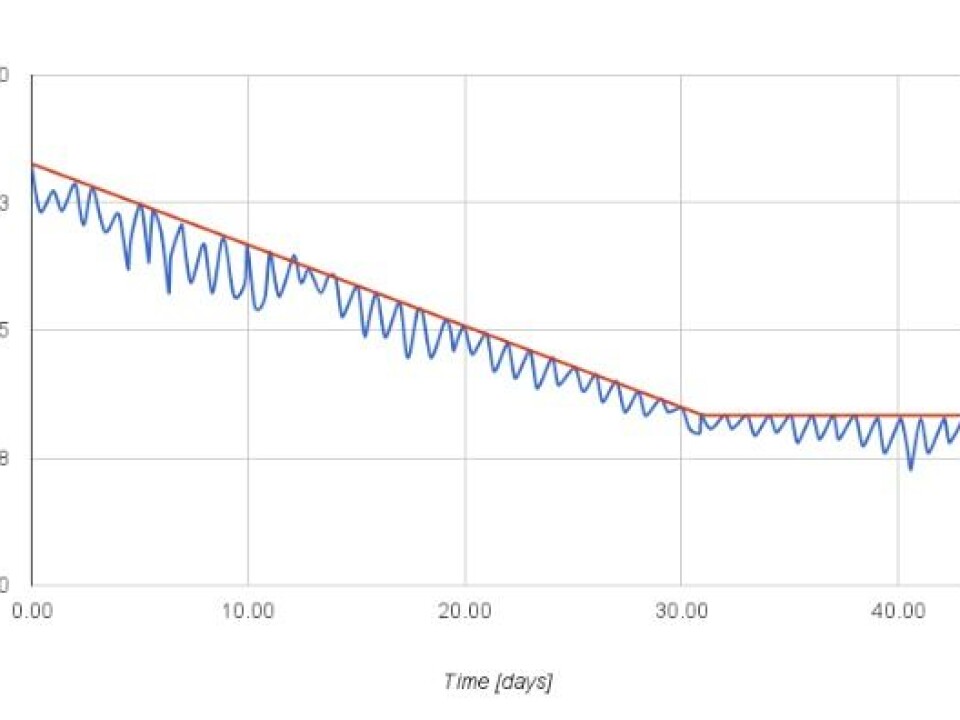
Scientist: lose weight effectively with a simple math-based diet
Can simple mathematics provide an effective and easy diet? Yes, says the scientist behind a new method, which will soon be available as an app.
The internet is awash with thousands of diets to help you lose weight by limiting certain foods or dishes. Many of them have just one problem: people quickly become tired of the restrictions and regain the weight as soon as they give up.
If you would rather eat more or less what you want and keep the weight off long-term, then you will need to try something different.
This is exactly what Professor Jakob Stoustrup from Aalborg University in Denmark claims to have done. With the help of relatively simple mathematics, he has lost seven kilograms in a month, and has managed to keep it off.
“The method can be used with your preferred diet, but of course it should be healthy food to avoid malnourishment. If you follow the method I describe, it’s mathematically guaranteed that you’ll achieve the desired weight loss,” says Stoustrup, who is a professor in control engineering in the Department of Electronic Systems at Aalborg University.
Eat less than your body burns

The essence of Stoustrup’s self-discovered diet is simple: eat and drink less than your body burns. His calculations are not based on calorie intake, but instead on how much the food and drink weighs.
For example, if your body has burnt of 800 grams since your last meal, then you should eat and drink a maximum of 799 grams in the next meal. If you want to lose more than one gram of weight, then you should eat even less, goes the argument.
Stoustrup decided that he was going to lose 7.4 kilogram in 31 days. That equates to a loss of 239 grams a day. That means that he should eat 239 grams less than what the body typical burns each day, which according to Stoustrup is between one and three kilograms of food.
“Before every meal, I weighed myself using a good pair of bathroom scales,” says Stoustrup.

He then compared this to how much he should weigh, according to his schedule. Subtracting one from the other gave him the weight of food and drink that he was allowed to consume for that meal.
“So after each meal, I was right on the weight curve that I had decided on beforehand,” he says.
Stoustrup also continued his usual exercise regime twice a week, and ate the same type of food as he always had, a mix of vegetables, meat, and fat--and the occasional chocolate and red wine.
Read More:19th century undertaker introduced the world to dieting
Amounts of food varied from day to day

There were big swings in eating habits along the way. Stoustrup ate more food on exercise days, sometimes more than he had the appetite for, to ensure that he stayed within the boundaries set by the experiment.
On the flip side, he ate significantly less the day after an indulgent evening of red wine and food with friends. This was because he had consumed extra energy the night before, so his body burnt that food and drink instead of burning up fat tissue.
After 31 days he had achieved his goal of losing 7.4 kilograms.
Read More: Very-high-fat diet reversed obesity and disease risk
Finished the diet without ever feeling hungry
“One of the reasons why people in the western world fight against weight gain and obesity, is perhaps because many people, including me, are used to eating even when they’re no longer hungry,” says Stoustrup.
“During the experiment, the funny thing was that I never felt hungry. I ate all the time and varied the diet. I already eat healthily so I probably consumed the right amount of vitamins and minerals, but because I remained on this constant balance, I never feel hungry at all,” he says.
The experiment is not published in a peer-reviewed scientific journal, but you can read about it an article by Stoustrup, part of the blog for the International Federation of Automatic Control.
Stoustrup’s research at Aalborg University is focused on optimising technical systems. The diet is not specifically supported by medical literature, and Stoustrup does not study obesity or nutrition.
Read More: High-fat cheese can be part of a healthy diet
Health researchers express interest
Despite its non peer-reviewed nature, Clinical Professor Bente Klarlund Pedersen from the University of Copenhagen, Denmark, and head of the TrygFondens Center for Active Health at Rigs Hospital, says that it’s worth to consider Stoustrup’s findings.
“It shows that perhaps we don’t focus enough on the amount of food [we eat]. We tend to think that if we eat something healthy, then eating twice as much of it must be twice as healthy. But that’s not the case if you want to lose weight. He [Stoustrup] has eaten steadily and monitored his weight relatively closely. If we all did the same when we start to gain some weight, then perhaps we could avoid dieting altogether,” says Pedersen.
She is surprised by how Stoustrup adjusted his food intake over such short time intervals.
“I don’t understand how he uses the weight changes he achieved in one day for anything. Partly due to inaccuracies in weighing scales. Partly because it depends on whether he has eaten enough carbohydrate for example, because that will bind a lot of water. It’s interesting. I can only understand it in terms of eating steadily in relation to his composition of carbohydrate, fat, and protein throughout the day,” says Pedersen.
Read More: Should you be using Facebook for health information?
“Really fun” if it can be expanded
Associate Professor Jens-Christian Holm, is a consultant in paediatrics and head of The Children’s Obesity Clinic and The Danish Childhood Obesity Biobank, where he studies optimal techniques for weight-loss among adults and children.
He too is impressed by Stoustrup’s success. Not least, because it totally disregards the otherwise complex ways in which the body regulates our weight.
“I like the fact that he makes very rough generalisations. Research focused on food products, energy per cent, proteins, fats, and carbohydrates, haven’t led to any breakthroughs in our understanding of treating the severely overweight,” says Holm.
“Theoretically, he could be on to something,” says Holm. “And it could be really fun if he is. Then patients could regulate their own consumption.”
Read More: Nordic diet lowers cholesterol – even without weight loss
Others could struggle to follow the regime
Obesity researcher, Lars-Georg Hersoug, thinks that one reason for Stoustrup’s success, was the fact that he enjoyed keeping track of his weight meal-by-meal.
“It’s a possibility that he stayed motivated to watch his weight because he was interested in the technicalities of it,” says Hersoug, a postdoc in the Department of Environmental Chemistry and Health at the University of Copenhagen, Denmark.
He doubts that most of us would be quite so keen in the long-run, but it could just help to motivate people and to get them on the right track.
Stoustrup is now developing an app that will be available both for Apple and Android, based on the spreadsheets that he developed during his test-diet.
You can read more about it on Stoustrup’s website, where you can also sign up as a beta-tester for the app.
--------------
Read the Danish version on Videnskab.dk
Translated by: Catherine Jex










